Alcaraz vs Sinner: Rome Final Recap
ball control — Globo Gym — extended wrists — proof-of-work
Carlos Alcaraz defeated Jannik Sinner 7/6 6/1 in the final of the Rome Masters on Sunday to clinch the number two ranking heading into Roland Garros later this month. The win also extends Alcaraz’s H2H to 7-4 over Sinner.
Seven months had passed since Alcaraz and Sinner last met in a breathlessly kinetic Beijing Final that was the match of the year for 2024. ‘Premeditated aggression’ summarises both their styles, but the nature of their aggression differs in subtle, but important, ways. Sinner, who in any given rally strikes his backhand at 73 mph — the tour average for forehands — is the eminent aggressive baseliner in today’s game largely because of his ability to trade in three important ball control characteristics: speed, depth, and direction. His willowy frame houses low and compact strokes that appear paradoxically liquid to the eye, able to seamlessly shift from rally gears into the red without warning. His demeanour is equally cool, complemented this week by Nike’s midnight-black polo. The successful return following a three-month forced hiatus is yet more evidence that the Italian is a well-oiled machine who needs little mileage to reach peak form.
Meanwhile, Carlos Alcaraz is more difficult to tag. Aggressive baseliner? That doesn’t quite capture it. All-court player? Sure, but he uses more of the court than that label even. He’s the closest thing to a paradox tennis has ever seen; you’re not supposed to have those volleys and that haymaker forehand, or that two-hander and that slice, Carlos. Yes, he’s also excellent in the three ball control characteristics mentioned — not quite on Sinner’s level — but he’s a genius in the final two ball control characteristics: height, and spin. In an era defined by linear fast balls (and Alcaraz certainly throws above his weight here) the Murcian possesses a mastery of the intangibles: deftly weighted low defensive slices, parabolic topspin loopers, camo drop shots, deflected return blocks; the feints and parries that trace the outer meridians of the felt and enhance his staccato attack. His stature is also off-script. In an era of slinky-enduro two-metre sliders, Alcaraz is compressed. Six-foot on paper but six-four in bounce. His on-court persona is also more colourful: smiles and roars both can accompany misses and winners, depending on the context. Nike also seems to lean into this a little more, and it was good to see the rivals donning different colorways. Today, with his NFL-esque nose strip Alcaraz appeared more Globo Gym. He’s the perfect foil to Sinner’s Gucci-tuxedo’d poker face, the Spaniard in the works of Sinner’s meshed baseline gears.


But enough waxing. Play.
First Set
Back in March I had lamented Alcaraz’s lack of variation in his loss to David Goffin at the Miami Masters. There, on the slicker hard courts, against a pin-balling Belgian, Alcaraz seemed to fight speed with more speed. I don’t think it’s his best avenue — even on hard — because he has so many tools to evade the rush-hour trap.
But two things helped clarify Alcaraz’s tactics at the Foro Italico today: one was the crushed red brick beneath his feet; the other was the man standing across from him. Both factors necessitate that the Spaniard lean into his shapeshifting abilities.
Alcaraz’s rhythm disrupting intentions were on display in the early stage, trying to elevate the ball into uncomfortable altitudes, but Sinner was having none of it, holding the line and smothering forehands like a hardcourt baseliner:

But Alcaraz has multiple clubs in his bag on that wing, and he used the backhand slice to good effect early, stinging this one low to force Sinner to create his own speed and lift. It bought Alcaraz time, and a shorter ball to attack, which he promptly drilled line:
By 2-2 we also started to get some serve trends: Alcaraz was going wide on both sides, trying to create open plains to ply his plus-one:
Sinner was more varied, and even jammed Alcaraz several times with good body serves when he stood closer in. His map may be partly explained by Alcaraz’s adjustments he kept making throughout the match (standing deeper at times, and closer in at others):
The match started to heat up around 2-2 after a somewhat sluggish start. Sinner’s running forehand again:

A slow-mo for the technephiles:

And a relevant excerpt from last year’s Sinner vs Tiafoe Cincinnati Final:
I contend this is where wrist extension in the forehand backswing really shines. Above you can see how Sinner’s racquet head drops from around shoulder height to waist height at the same time he drives the elbow forward; he’s tapping into gravity for speed and keeping the wrist mechanics quiet. I don’t believe flexed forehand setups get that benefit.
Alcaraz also earned a break point in this game, helped by his parabolic forehand potency:

“He’s getting so much purchase with the forehand. Great length. So much height and rearing up to Sinner."
— Tennis TV
But Sinner would save that on a missed forehand return from Alcaraz.
It wasn’t until the sixth game and nearly forty points in that we also got the first Alcaraz drop shot. True to form, it was off his forehand, and played in the opposite direction to Sinner’s split-step momentum. By my count the Spaniard went 4/5 when playing the forehand drop shot today, the lone miss being a pretty easy backhand lob that he pulled wide.
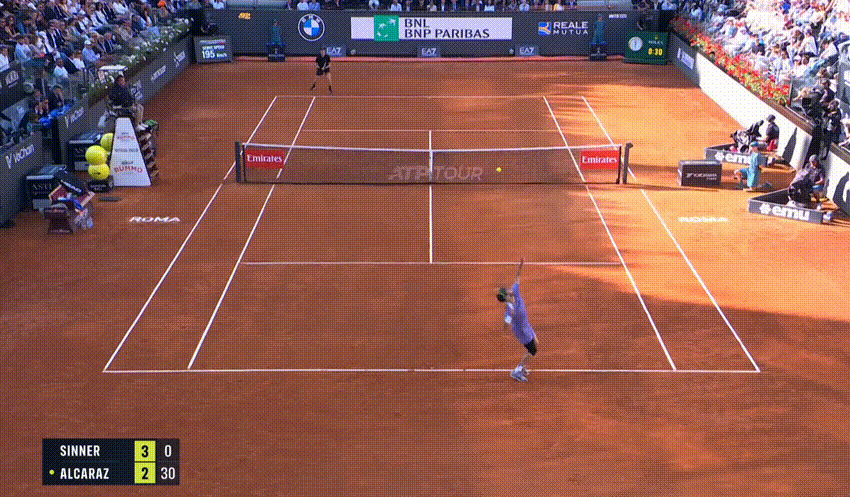
Alcaraz had half a look on Sinner’s service game at 3-3 30-30, sinking his teeth into a longer rally and diligently staying with his lofted ball flight strategy, but Sinner hit a nasty hook forehand and followed it up with one of those scissor-kick backhands he hits better than anyone. It was a rare backhand line winner today, after a week where he hit line backhands better than I can ever remember.

Both held easily to 5-6, where poor serving from Alcaraz found himself down 15-40 and two set points. However, Sinner showed his big-match rust, missing a routine forehand return, and then tapping out of the 30-40 rally with a rash line backhand. The Spaniard held to force a tie-breaker.
On the opening point Sinner ventured forwards, perhaps for the first time all match, and Alcaraz did what he always does: get the ball below the net. Here was a textbook example of the intangible gulf between the pair:
Tennis Insights produced an interesting graph before today’s final, displaying the average volley height both men forced on the other in their Beijing affair last year. Alcaraz, especially with that defensive slice backhand, is so good at finding the forecourt shoelaces of his opponents. He kills conversion scores for a living.
Compounding Sinner’s problems, Alcaraz’s serve caught fire at the start of the breaker, hitting his first three serves unreturned to open up a 4-2 lead on the changeover.
At 5-4 Alcaraz had two serves to seal the set. On the first he stuck to the playbook, kicking it wide to set up a forehand to the open court. Sinner had trouble making inroads returning the backhand on the ad-side all match, and it was a bit surprising — as the commentators noted — that the Italian didn’t make some positional adjustments on that wing.

The set point was perhaps the best of the match, and the most unpredictable. Alcaraz had kept a lid on his spontaneous North-South movement steals, but he couldn’t contain himself on set point, sneaking in to play a brilliant little cut backhand drop-volley on an unsuspecting Sinner.
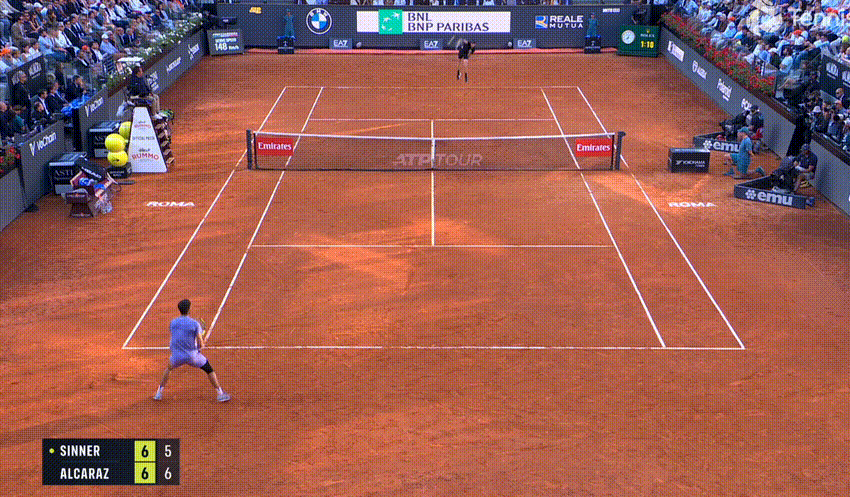
Second Set
Sinner’s first-serve percentage fell off a cliff in the second set. He only hit 23% in for set two. Against the best second-serve returner in the game, the scorecard was always going to get ugly.
But it was actually Alcaraz who first found himself in a hole, down 0-30 in the opening game. That’s a hell of an angle to help dig yourself out.
Alcaraz then broke Sinner to love to open up a 2-0 lead, and the front-running confidence that streaks so many champions came to the fore. There were periods in the middle of this set where the Spaniard threaded trademark magic.
This. Is. Alcaraz
It should be noted that Sinner’s lack of recent matches likely contributed to his diminished serving after that physical first set. While he has shown he can hit peak form in a matter of sets, match fitness isn’t something that can be bottled in a stroke; it must be continually mined like some cryptographic proof-of-work. You can bet the body is sore after six matches, and perhaps those blisters that were giving him grief in the semifinals were starting to bleed more into this performance.
The final nail in the coffin was, perhaps fittingly, off that Alcaraz defensive slice backhand, dropping fast and short, forcing a volley error from Sinner to go down a double-break:
“And so you can look at these two unbelievable ball-strikers, but actually, in a match like this, there have been crucial points won and lost at the net. You think of the tie-breaker, the great volley Alcaraz hit on set point, the volley Sinner missed at the beginning of the tie-breaker. Was that the final chance for Sinner?”
— Tennis TV
Sinner did have looks in other games, but here’s another camo’d dropper at 30-30. Out of nowhere.
Championship point was also won with a lunging forehand volley.
The win completes Alcaraz’s clay court Masters resume, having already won Madrid and Monte Carlo. 19-6 career record in finals. Here’s the jaw-dropper: he’s 11-1 at Slam and Masters 1000 level finals. The lone loss coming to Djokovic in that Cincy final from two years ago.
Say what you will about the inconsistent early exits at times…
*Alcaraz reaches a final*
As does Sinner:
Both men are brushing shoulders with elite territory.
There’s a possible rematch in a Roland Garros final in a couple of weeks time now that Alcaraz is back to number two on the computer. The good news for Sinner fans is that the Italian has three weeks and six matches between his next possible rendezvous, and given the form he has shown, I think it’s fair to say that both men will be bitterly disappointed to leave before the final.
So would I. Peak tennis sustains me, and I’ve missed this matchup.
I’ll be back soon. See you in the comments. HC.
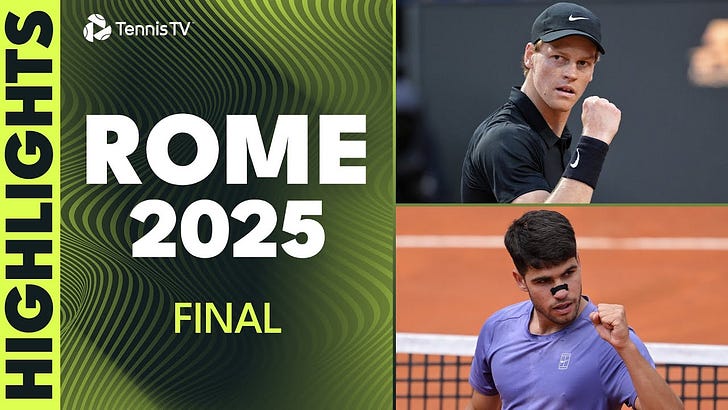


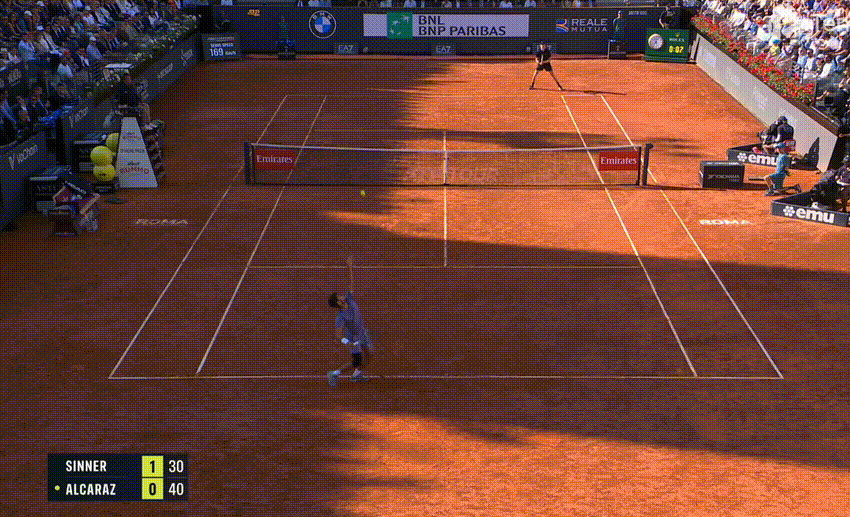

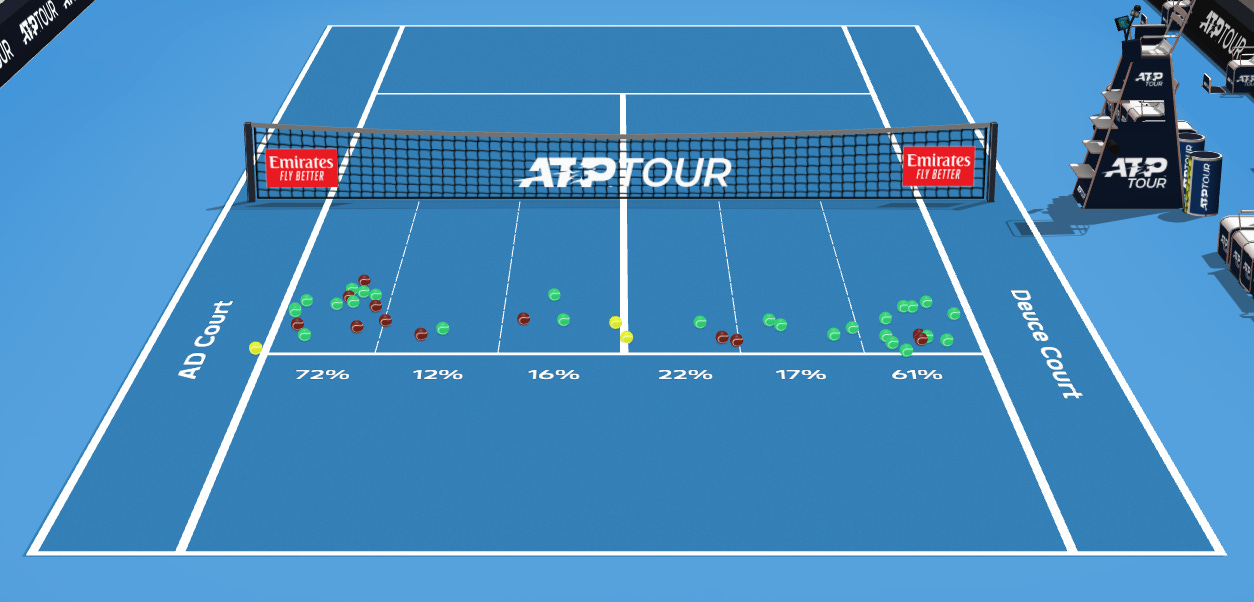




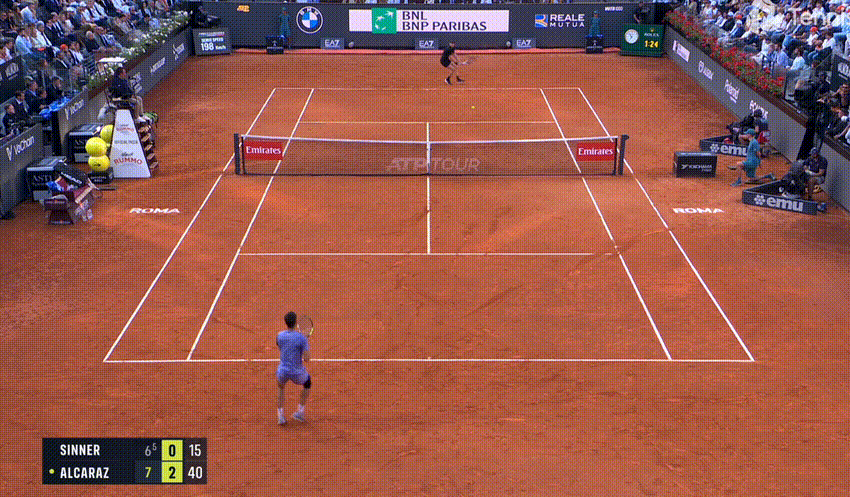



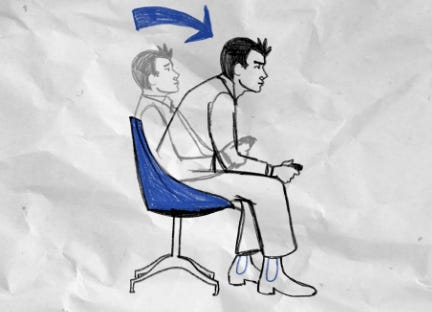
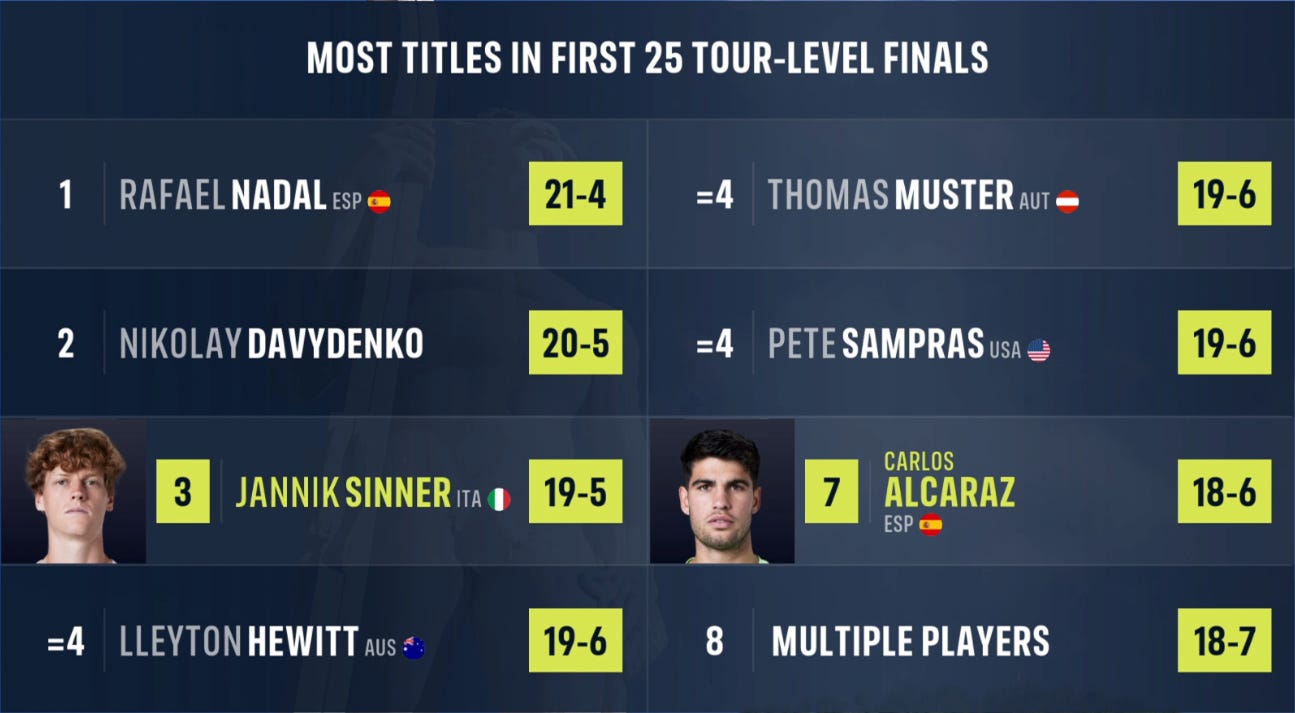
I tuned in to Sinner's practice court the day of the final. He was being fed high and deep loopy baseline balls and doing his best to crush them. Would he be doing that drill ahead of any other match-up? I found it interesting.
P.S. A terrific read - thank you!
I was waiting for that analysis thank you so much Hugh ! Always inspiring and learning a lot from your articles to make my own analysis article even sharper ! Wish this had more visibility cause it is gem for hardcore fans like most of us are ! So glad for alcaraz and the clear favorite to RG even without having to show his best tennis yet imo ! Won those tournaments with some margin and overall higher average level on clay ! Looking tough to beat in best of 5 on clay